Bemelmans J. et. al. (editor) Elliptic and Parabolic Problems: Rolduc and Gaeta 2001
Подождите немного. Документ загружается.

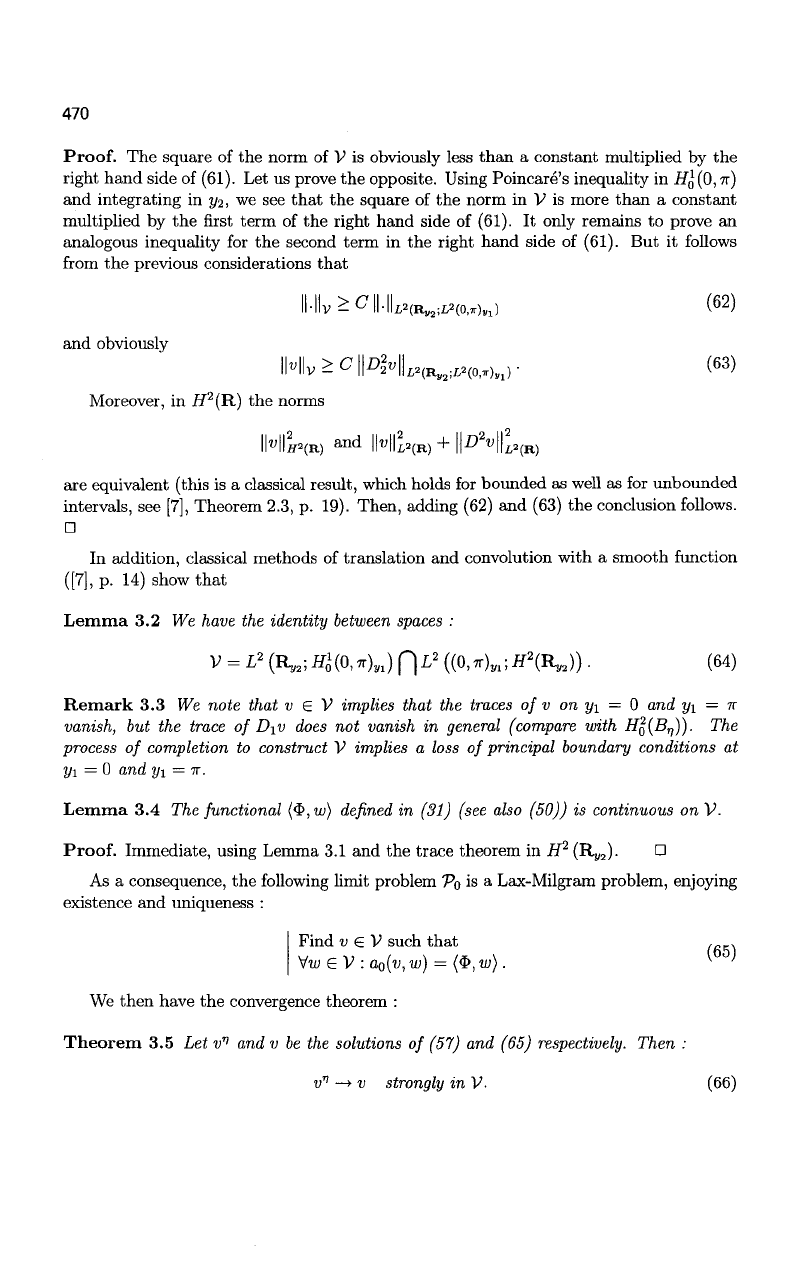
470
Proof.
The
square
of the
norm
of
V
is
obviously less than
a
constant multiplied
by the
right hand side
of
(61).
Let us
prove
the
opposite. Using Poincare's inequality
in
Hi(0,7r)
and integrating
in y2, we see
that
the
square
of the
norm
in V is
more than
a
constant
multiplied
by the
first term
of the
right hand side
of
(61).
It
only remains
to
prove
an
analogous inequality
for the
second term
in the
right hand side
of
(61).
But it
follows
from
the
previous considerations that
ll-llv>C||.||
L2(Rv2;L2(
o,.
)vi)
(62)
and obviously
\M
v
>C\\Dlv\\
LHRs2]L2(0ir)yiy
(63)
Moreover,
in H
2
(R) the
norms
IMI^(R)
and
IMI^(R)
+
||£>
2
HlL(R)
are equivalent (this
is a
classical result, which holds
for
bounded
as
well
as for
unbounded
intervals,
see
[7], Theorem 2.3,
p. 19).
Then, adding
(62) and (63) the
conclusion follows.
•
In addition, classical methods
of
translation
and
convolution with
a
smooth function
([7],
p. 14)
show that
Lemma
3.2 We
have
the
identity between spaces
:
V = L
2
(H^JHJIO,^)
f]L
2
((0,7r)
yi
;fl
a
(H,
B
)) . (64)
Remark
3.3 We
note that
v e V
implies that
the
traces
of v on yi = 0 and yi = n
vanish,
but the
trace
of D\V
does
not
vanish
in
general (compare with
H^B^)).
The
process
of
completion
to
construct
V
implies
a
loss
of
principal boundary conditions
at
yi
=
0 and
y\ = IT.
Lemma
3.4
The functional
($,w)
defined
in (31) (see
also
(50)) is
continuous
on V.
Proof.
Immediate, using Lemma 3.1
and the
trace theorem
in H
2
(Rj,
2
).
•
As
a
consequence,
the
following limit problem
VQ
is a
Lax-Milgram problem, enjoying
existence
and
uniqueness
:
Find
DSV
such that
, .
VweV: a
0
(f,w)
=
($,w).
*• '
We then have
the
convergence theorem
:
Theorem
3.5 Let v
n
and
v
be
the
solutions
of (57) and (65)
respectively. Then
:
v
n
—>
v
strongly
in V- (66)
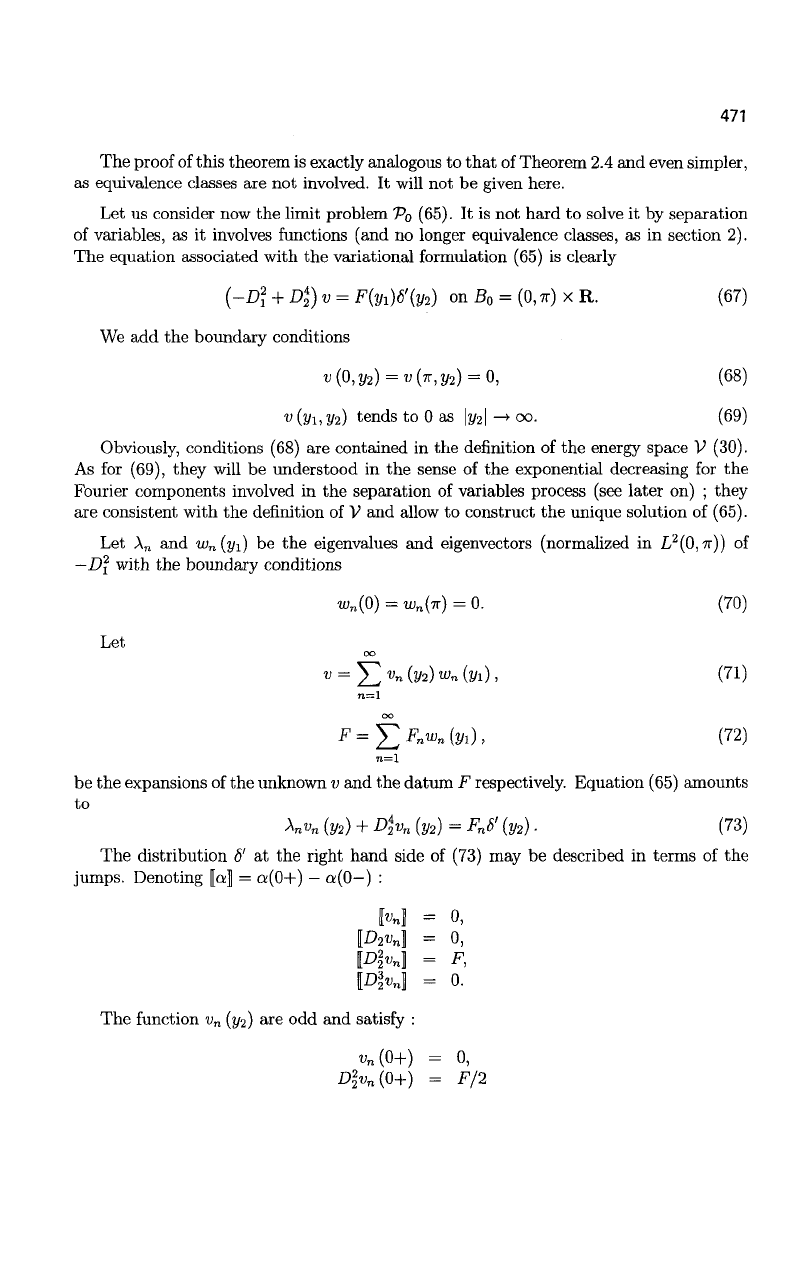
471
The proof of this theorem is exactly analogous to that of Theorem 2.4 and even simpler,
as equivalence classes are not involved. It will not be given here.
Let us consider now the limit problem Vo (65). It is not hard to solve it by separation
of variables, as it involves functions (and no longer equivalence classes, as in section 2).
The equation associated with the variational formulation (65) is clearly
(-D\ + B}) v = F(
yi
)6'(y
2
) on B
0
=
(0,
TT)
X R. (67)
We add the boundary conditions
w(0,lft) = «(jr,ift) = 0, (68)
v (2/1,3/2) tends to 0 as \y
2
\
—>
00. (69)
Obviously, conditions (68) are contained in the definition of the energy space V (30).
As for (69), they will be understood in the sense of the exponential decreasing for the
Fourier components involved in the separation of variables process (see later on) ; they
are consistent with the definition of V and allow to construct the unique solution of (65).
Let A
n
and w
n
{y
1
) be the eigenvalues and eigenvectors (normalized in L
2
(0,7r)) of
—D\
with the boundary conditions
w„(0) = w
n
(n) = 0. (70)
Let
OO
v
=
5Z
Vn
(&)
Wn
(y^'
(
71
)
n=l
00
F = Y, FnVn (Vl) , (72)
n=l
be the expansions of the unknown v and the datum F respectively. Equation (65) amounts
to
A»«» (») + D\v
n
(jft) = FJ (a,). (73)
The distribution 5' at the right hand side of (73) may be described in terms of the
jumps. Denoting [a] = a(0+)
—
a(0—) :
K] = 0,
[D
2
v
n
] = 0,
[Z?K] = F,
lD
3
2
v
n
] = 0.
The function v
n
(y
2
) are odd and satisfy :
v
n
(0+) = 0,
D
2
2
v
n
(0+) = F/2

472
and we have explicitly
' u
n
(2/2) is odd,
< u
n
(y
2
) = -^— (e"*» - e^») for y
2
> 0, (74)
, where a± = 2^/2
A
i/4
(
_
1±i)
We then have the explicit expression of the solution, which is exponentially decreasing
for I2/2I -* 00. It should be mentioned that, as the exponents are not real, the graph of
u
n
(2/2) cuts the axis of abcissas infinitely many times.
Remark 3.6 The same problem may be considered with a singularity of lower order in
the right hand side, namely
f{x
u
x
2
) = F(x
1
)6(x
2
)
:
which does not belong to the dual of V
a
defined in (52). The developments are analogous
to the previous ones, but (56) is replaced by
u
c
(x) = -v^(y) (75)
and the right hand side of (57) is presently
TV
($,«,) = / F{y
1
)w(y
1
,0)dy
l
.
0
Obviously, in the limit problem (67), 6' must be replaced by 6. Its explicit solution is
obtained as before and is now an even function in y
2
.
4 Layers along a boundary with a Neumann bound-
ary condition
In this section, we consider the previous problems in the domain
n = (0,jr)x(0,l), (76)
instead of (13). The boundary conditions will be of Neumann type on x
2
= 0, whereas
they remain unchanged on the rest of the boundary.
We first consider (14), (15) on the space
V = {v | v e
H
2
(Q),
v = d
n
v = 0 on x
x
= 0, x
1
=
TT,
X
2
= l} (77)
and the functional of the right hand side is still given by (24). This amounts to
(-A +
e
2
A
2
)
u
£
= 0 infi, (78)
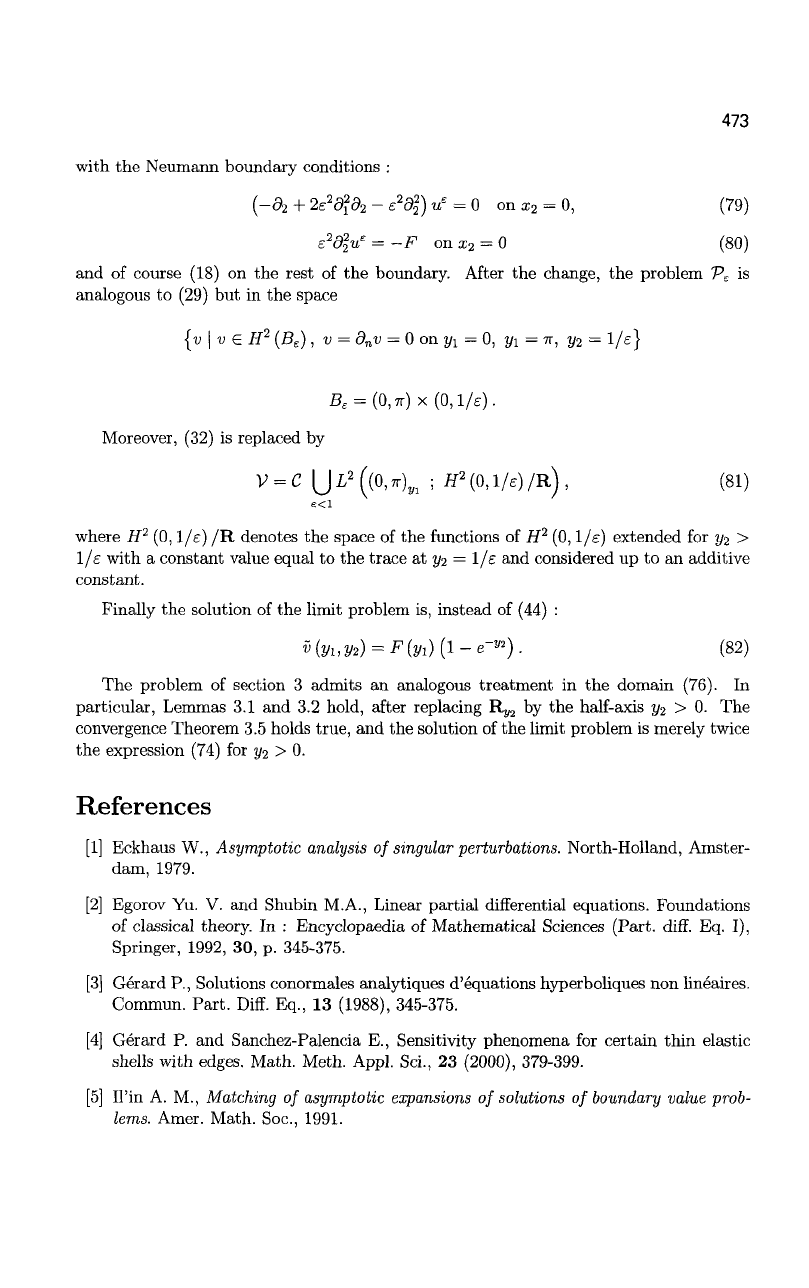
473
with
the
Neumann boundary conditions
:
(-<9
2
+
2e
2
<9
1
2
d
2
-
e
2
<9
2
)
u
c
= 0
oni
2
= 0, (79)
e
2
d
2
u
e
= -F
oni
2
=0
(80)
and
of
course
(18) on the
rest
of the
boundary. After
the
change,
the
problem
V
e
is
analogous
to (29) but in the
space
{v
| v
G
H
2
(B
e
), v = d
n
v = 0 on y
l
= 0, y
1
=
TT,
y
2
= 1/e)
B
£
=
(0,7r)x(0,l/e).
Moreover,
(32) is
replaced
by
V
=
C
UL
J
((M)
B
;
ff
2
(0,l/e)/R),
(81)
e<l
where
H
2
(0,1/e)
/R
denotes
the
space
of the
functions
of H
2
(0,1/e) extended
for
y%
>
1/e
with
a
constant value equal
to the
trace
at y
2
= 1/e and
considered
up to an
additive
constant.
Finally
the
solution
of the
limit problem
is,
instead
of (44) :
v(yi,y2)
=
F(
yi
)(l-e-y>).
(82)
The problem
of
section
3
admits
an
analogous treatment
in the
domain
(76). In
particular, Lemmas
3.1 and 3.2
hold, after replacing
R^ by the
half-axis
y
2
> 0. The
convergence Theorem
3.5
holds true,
and the
solution
of
the limit problem
is
merely twice
the expression
(74) for y
2
> 0.
References
[1] Eckhaus
W.,
Asymptotic analysis
of
singular perturbations. North-Holland, Amster-
dam,
1979.
[2] Egorov
Yu. V. and
Shubin
M.A.,
Linear partial differential equations. Foundations
of classical theory.
In :
Encyclopaedia
of
Mathematical Sciences (Part.
diff. Eq. I),
Springer,
1992, 30, p.
345-375.
[3] Gerard
P.,
Solutions conormales analytiques d'equations hyperboliques
non
lineaires.
Commun. Part.
Diff. Eq., 13
(1988), 345-375.
[4] Gerard
P. and
Sanchez-Palencia
E.,
Sensitivity phenomena
for
certain thin elastic
shells with edges. Math. Meth. Appl.
Sci., 23
(2000), 379-399.
[5] IPin
A. M.,
Matching
of
asymptotic expansions
of
solutions
of
boundary value prob-
lems. Amer. Math.
Soc, 1991.
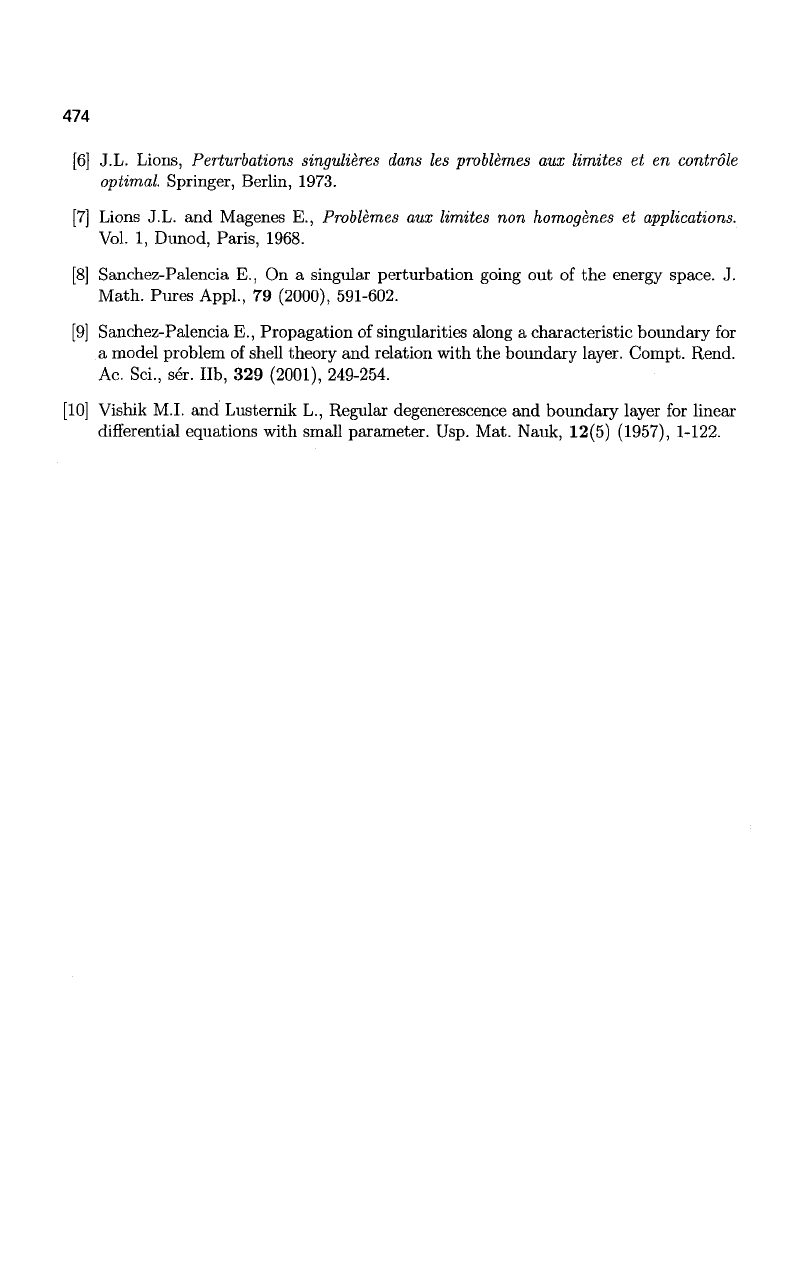
474
[6] J.L. Lions, Perturbations singulieres dans les problemes aux limites et en controle
optimal. Springer, Berlin, 1973.
[7] Lions J.L. and Magenes E., Problemes aux limites non homogenes et applications.
Vol. 1, Dunod, Paris, 1968.
[8] Sanchez-Palencia E., On a singular perturbation going out of the energy space. J.
Math. Pures Appl., 79 (2000), 591-602.
[9] Sanchez-Palencia E., Propagation of singularities along a characteristic boundary for
a model problem of shell theory and relation with the boundary layer. Compt. Rend.
Ac.
Sci., ser. lib, 329 (2001), 249-254.
[10] Vishik M.I. and Lusternik L., Regular degenerescence and boundary layer for linear
differential equations with small parameter. Usp. Mat. Nauk, 12(5) (1957),
1-122.

Regularity and uniqueness results for a phase change
problem in binary alloys*
Jean-Frangois Scheid
1
, Giulio Schimperna
2
1 '
Institut de Mathematiques Elie Cartan, Universite de Nancy 1
F-54506 Vandoeuvre-les-Nancy Cedex, Prance
2
Dipartimento di Matematica, Universita di Pavia
Via Ferrata, 1,
1-27100
Pavia, Italy
Email : scheid@iecn.u-nancy.fr ; giulio@dimat.unipv.it
Abstract
An isothermal model describing the separation of the components of a binary
metallic alloy is considered. A phase transition process is also assumed to occur in
the solder; hence, the state of the material is described by two order parameters,
i.e., the concentration c of the first component and the phase Held ip. Existence
of a solution to the related initial and boundary value problem has been proved
in a former paper, where, anyway, uniqueness was obtained only in a very special
case.
Here some further regularity and uniqueness results are shown in a more
general setting using an a priori estimates - compactness argument. A key point
of the proofs is the analysis of the fine continuity properties of the inverse map of
the solution-dependent elliptic operator characterizing one of the equations of the
system.
1 Introduction and mathematical preliminaries
In this paper, we aim at presenting some regularity and uniqueness results for the system
dttp-Atp = F
1
{ip) + c +
F
2
{^),
d
t
c
—
div (ji
(tp,
c) Vw) = 0, (1)
w e -Ac +
(3
(c) + 7 (c) + g (tp),
describing the diffusive separation of components in a binary metallic alloy possibly un-
dergoing a phase transition phenomenon. In the above relations (1), the unknown c
represents the relative concentration of either of the components, while tp is the phase
parameter, with
<p
= 0 denoting the solid, tp = 1 the liquid, and 0 <
<p
< 1 a mixture.
Moreover, F
1:
F
2
, 7 and g are smooth coupling terms whose meaning is outlined in the
'This work was partially supported by the Istituto di Analisi Numerica del CNR-Pavia, Italy
475

476
paper [4]. Finally, /i is the mobility coefficient, possibly depending on both the unknowns,
but assumed to be nondegenerate, and
(3
is a maximal monotone graph guaranteeing the
"physical" constraint 0 < c < 1.
Let us point out that the system (1) has to be complemented with the Cauchy con-
ditions for ip and c and with homogeneous Neumann boundary conditions for
<p,
w and
c. Under such assumptions, problem (1) has been studied in [4], where existence and
regularity results were proved for a variational formulation of that system. However, the
question of uniqueness was solved just in the very particular case when fi is a constant.
Hence, in this paper we deal with two more general settings, where the mobility
fj,
may
depend either on the sole unknown
ip
or on both the unknowns
(</?,
c), and we are able to
show two distinct uniqueness and continuous dependence results. Indeed, both situations
seem to be significant on the physical viewpoint [4, Introduction]. In order to prove the
second result, we have to assume very strong smoothness properties of the solutions. In
this direction, we actually prove a new regularity theorem for the solution of (1) that fits
with the uniqueness setting at least for suitably small final times. The main analytical
instrument on which we rely consists in a fine analysis of the continuity properties of
the solution-dependent elliptic operators resulting from the nonconstant mobility fi. This
follows the lines of the work [1], where similar arguments were used for the study of the
Cahn-Hilliard system with nonconstant mobility.
Let us now start briefly presenting some mathematical notations and tools that will
be used throughout the rest of the paper. Let fi be a smooth, bounded and connected
domain in M
3
(the situation in the two-dimensional case is analogous and is even easier in
the one-dimensional one) and let T > 0 be a given final time. Set T := <3fi, E := T x (0, T),
Q
t
:= fi x (0,t), for t e (0,T] and Q := Q
T
. Set also H := L
2
(fi) and V := H\n) and
endow the latter space with its usual scalar product.
{{v,w)) := / vwdx+ Vu -Vwdx. (2)
J n J n
We identify H and its dual, in order that the compact inclusion H C V holds and
(V, H, V) form a Hilbert triplet. Denote by (•, •) the scalar product of both H and H
d
(fi),
by |-1 the associated norms and by ||
•
\\
x
the norm of the generic Banach space X. Finally,
indicate by (.,.) the duality pairing between V and V and by ((., .))„ the associated scalar
product on V.
Given any £ € V, let us now set
(
n
:=±(C,l); V^.= {CeV:Cn = 0},
V
0
:=VnVi.
(3)
Let also 0 < a < fi
0
be assigned constants and let
fi 6 Lip
ioc
(R
2
), with a< fi<n
0
a.e. in K
2
. (4)
If v, z : Q
—>
R are measurable functions, then we can define the operators
B(
VlZ
) : V -> V, (B
M
u, y) := /
p.
(v, z)
VM
•
Vydx, for u, y € V, (5)
J n
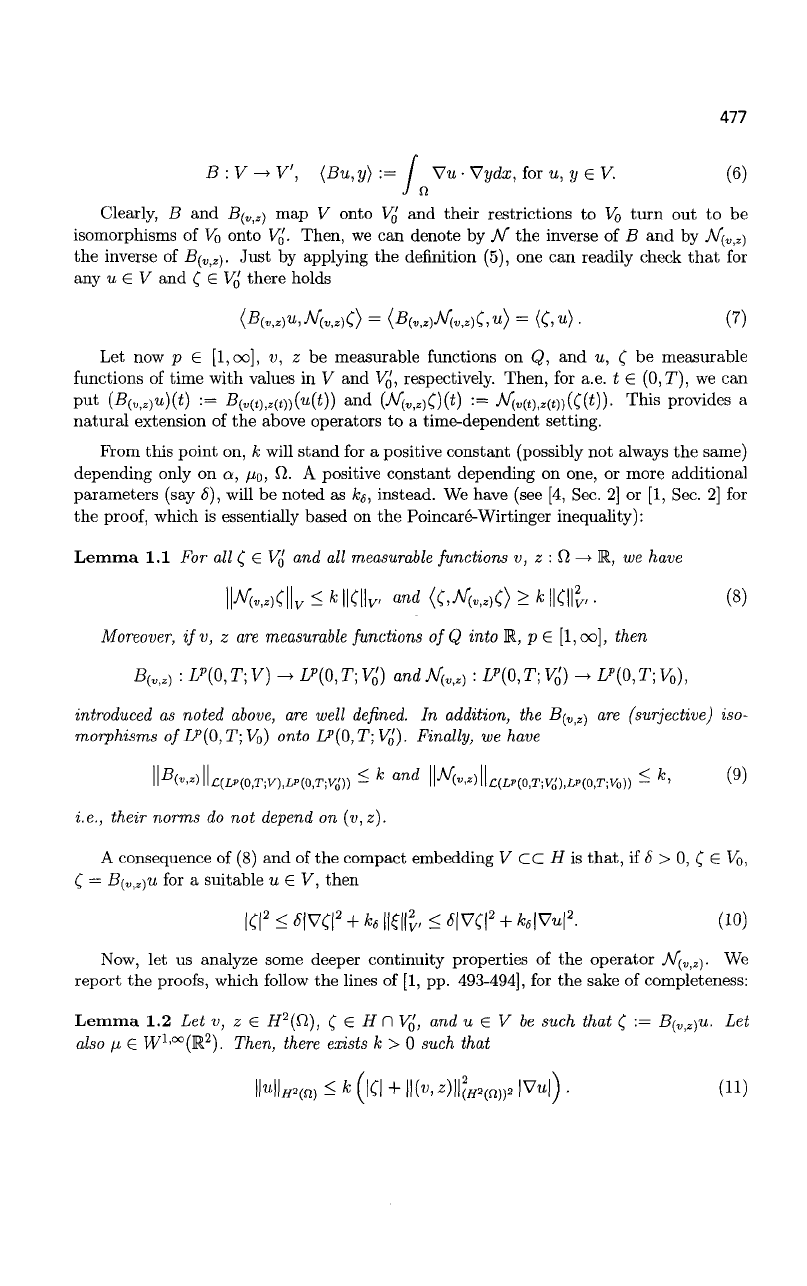
477
B:V^V,
{Bu,y) := / Vu
•
Vycte, for
u,yeV.
(6)
J n
Clearly, B and f$(„,
z
) map V onto VJJ and their restrictions to
VQ
turn out to be
isomorphisms of V
0
onto
VQ.
Then, we can denote by Af the inverse of B and by Af(
v
,z)
the inverse of -B(„
jZ
). Just by applying the definition (5), one can readily check that for
any u € V and (e VJ there holds
(B
M
u,N(?,z)0 = (
B
(v,z)N
M
t,u) = (C,u> . (7)
Let now p £
[l,oo],
u, Z be measurable functions on Q, and u, £ be measurable
functions of time with values in V and
VQ,
respectively. Then, for a.e. t € (0,T), we can
put (B
M
u)(t) := B
(v(t)iZ(t
)){u{t)) and (A/"
(
„
iZ)
C)(£) := A/(„(i),*(t))(C(<))- This provides a
natural extension of the above operators to a time-dependent setting.
Prom this point on, k will stand for a positive constant (possibly not always the same)
depending only on a,
fiQ,
O. A positive constant depending on one, or more additional
parameters (say 6), will be noted as kg, instead. We have (see [4, Sec. 2] or [1, Sec. 2] for
the
proof,
which is essentially based on the Poincare-Wirtinger inequality):
Lemma 1.1 For all ( £ V
0
' and all measurable functions v, z
:
Q
—>
M, we have
||JW||
V
^
k
IKHv
md
<C,JV(»,.)C) > k
\\C\\
2
V
,.
(8)
Moreover, ifv, z are measurable functions of Q into K, p £
[l,oo],
then
B
M
: 77(0, T; V) -
V^T'X)
and M
M
: i7(0,T; V
0
') - L"(0,T; V
0
),
introduced as noted above, are well
defined.
In addition, the S(^,
z
) are (surjective) iso-
morphisms of L
P
(0,T;V
0
) onto 1^(0,T;
VQ).
Finally, we have
\\
B
(
v
'
z
)\\c(LP(0,T;V),LP(0,T;V^) —
k and
II^W) \\c(LP(p,T;V£),W(0,T;V
o
)) —
fc
> ^>
i.e., their norms do not depend on
(v,z).
A consequence of (8) and of the compact embedding V CC H is that, if 6 > 0,
C,
£ Vo,
C
—
B(„
]Z
ju for a suitable u £ V, then
Kl
2
< «|VC|
2
+ fcs Ut, < <5|VC|
2
+ fc,|V«|
2
. (10)
Now, let us analyze some deeper continuity properties of the operator Af(
v
,z)- We
report the proofs, which follow the lines of
[1,
pp. 493-494], for the sake of completeness:
Lemma 1.2 Let v, z £
H
2
(fl),
f 6 ii" n VJ,', and u £ V be such that £ :=
B(
V<Z
)U.
Let
also \x e W
1,0
°(R
2
). T/ien, i/iere ezisfe fc > 0 such that
IMI^(n) < fc (iCI +
ll(^)ll(tf
W
|Vu|) . (11)

478
Proof.
Since
£ £ H, our
hypotheses
on v, z,
(J,
guarantee that
u is in
H
2
(£l)
and
satisfies
—div(/i(v,
z)Vu) = £, in H.
We deduce that
:
—n(v,
z)Au =
(Vfi(v,
z))
•
Vu + ( in H and
consequently
/ |-Aw|
2
dz<fc|C|
2
+ fc / (\Vv\
2
+
\Vz\
2
)\Vu\
2
dx.
Now, using elementary interpolation, Sobolev's embedding theorem,
and
Young's
in-
equality,
we
obtain
IMI
tf
2
(«)
VI
VI
<
k(\u\
2
+
\-Au\
2
)
k\C\
2
+
k(\\vf
H
^
)
+
k\C\
2
+ k(\H
i
HHn)
+
\\
Z
\\H'(CI)J
IMIjfCn))
|V«|
\H\
H
2
{n)
|V«|
2
+ \
||«||^
(n)
Lemma
1.3 Lei u, w, z, (
be
functions from
Q
into
R,
wifft
£ =
B(
V
^)U,
a.e. in
(0,T).
Then,
the
following formulas hold whenever they make sense
:
i
i /»
((B
M
u)
t
,u)
=
-—{B
M
u,u)+ n(v,z)
t
|Vu|
2
dx,
(12)
({B(
VlZ
)u),u
t
)
=
-—(B(
ViZ)
u,u)- fj,(v,z)
t
\Vu\
2
dx.
(13)
Proof.
Let us
assume that
all the
functions
are
sufficiently regular
to
give sense
to the
integrations
by
parts below. Then
we
have
((•B(„,
z
)u)
t
,
u) = — {B
M
u, u) - (B
M
u, d
t
u)
=
/
d
t
{ii{v,z)\Vu\
2
)dx-\
[
n(v,z)d
t
\Vu\
2
dx
=
2/
<9t(M^)|Vu|
2
)<fa
+ - /
^,z)
t
|Vu|
2
dz,
•/It
J it
so that
(12) is
proved
in the
regular case
and in
general
we can
conclude using
a
density
argument.
The
proof
of (13) is
analogous.
•
2 Main results
Let
us
give
the
main assumptions
on the
data
of the
problem.
Let K > 0 and
\Fi\
•
l-Pal.
M ,
Ifll,
\F{\, \K\, W\,
\g'\
< K a.e. in R,
>Po
e H,
co
e
y,
/3
C 1 x R is a
maximal monotone graph such that
0 £
/? (0),
^ '
c
n
£
intD
(/?),
where
c
a
=
(c
a
)\
n
•

479
Here
t/>
: K—•
[0,
+00] is a convex and lower semicontinuous function such that 0 = dip
and
i>
(0) = 0 and the domain of the graph
(3
is required to fulfill
£(/3):={reR:/?(r)^0}c[O,l]. (15)
Then, the following existence-regularity result [4, Thms. 3.1, 3.3, 3.4] holds :
Theorem 2.1 Let assumptions (4), (14)-(15)
hold.
Then there exists a quadruple
Up,
c,
w, f)
such that
c
G
H
1
(0,
T; V) n L°°
(0,
T; V)
l~l
L
2
(0,
T; if
2
(fi)),
«J6L
2
(0,T;F),
£eL
2
(0,T;H).
The quadruple (tp,c,w,£) satisfies
(16)
d
t
ip +
B<p
= Fi (p) + cF
2
{ip)
in V, a.e. in
(0,T),
d
t
c +
B(p
)C
)w
= 0 in V, a.e. in (0,T).
w = Be + £ + 7 (c) + 5
(</>)
inV, a.e. in (0,T).
£ € /3(c) o.e. in Q,
¥>(.,0) = </3
0
(.), c(.,0) = co(.) o.e. infi,
c(«)
n
= c
n
/oraW*e[0,T].
(17)
If in addition
¥>o
e V, (18)
i/ien
</>
satisfies
<p£H
l
(0,T;H)n C°
([0,T];
V) n L
2
(0,T; tf
2
(H)) (19)
and i/
<p
0
£H
2
{Q,),
5„v?
0
= 0 a.e. onT, (20)
iften
<^
ftas i/ie additional regularity
tp
e
w
1
'™
(0,
T; H) n ff
1
(0,
T; V) n L°°
(0,
T; ff
2
(«)) fll
2
(0, T; #
3
(fi)) . (21)
Finally, just under the assumptions (4),
(14)>
if
M
(fi
c
) *
s
constant, then the solution
(ip,c,w,^) is unique.
Under more restrictive hypotheses on the data, we are able to prove additional regu-
larity properties of the solution(s). We will possibly assume
fi = \i
Up)
only depends on
<p,
, ,
new
1
'™,
||MlU-<ff-
{
'
Theorem 2.2 Let (4), (14)-(15), (20) and (22) hold for a couple of initial data
ipo
t
i,
Co,i
and
</?o,2)
co,2 and assume that
(cb,i)
n
= (co,
2
)„
•
(23)
